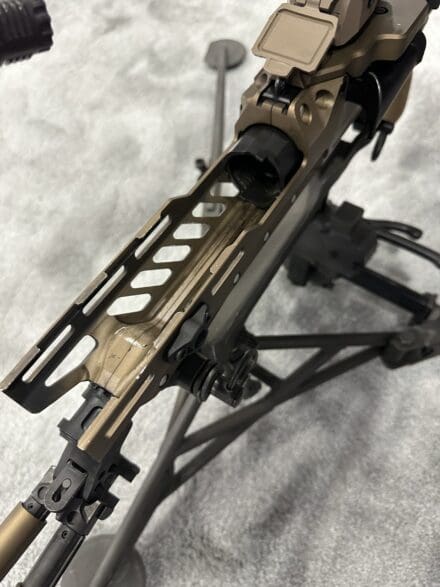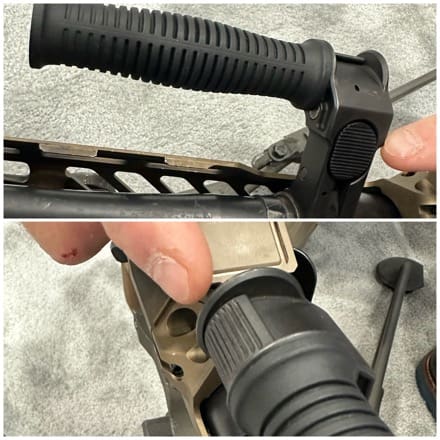This is an XM250 in 6.8x51mm. Essentially, it’s the same Automatic Rifle the Army adopted under the Next Generation Squad Weapons program with one exception, it has a quick change barrel. That feature, makes it quite suitable to fulfill the role as a sustained fire, belt-fed machine gun.
This isn’t a new characteristic. It was part of the original design, but the Army didn’t want a quick change barrel as part of NGSW. So, in order to save weight, it was left off. This version of the SIG light machine gun is referred to as the “World” configuration as it is how the gun is marketed to everyone else, except the US Army.
What Makes It Different
As you can see, it is configured here with no top cover over the barrel to facilitate quick barrel changes. However, SIG tells me there is a hinged cover available, as seen on the MG338.
The barrel is locked in place via two buttons. It can’t be removed or secured in place without simultaneously depressing the rocker and secondary locks. Additionally, the plunger must be depressed to fully engage the handle lock.
Here you can see the lugs on the barrel which lock the barrel into the receiver.
Why It Matters Now
The Squad Arms and Ammunition Configuration study led to the development of the 6.8 cartridge and Next Generation Squad Weapons. Afterwards, a study was conducted for the Platoon called, aptly enough, the PAAC study. Although it was completed well over a year ago, Army leaders continue to evaluate the study’s findings to decide on a path forward.
One of the key decisions is how to proceed regarding a machine gun for the platoon. Options under discussion include adopting the 6.8 common cartridge architecture for the role, as well as seeking out an additional cartridge such as the 338 Norma Mag option currently under adoption by USSOCOM.
Regardless of the caliber choice, fielding of the initial XM250 Automatic Rifles to the first units is already highlighting the disparity between the new 6.8 round and its 7.62 predecessor. The current M240s are heavier, offer reduced range and lower delivered energy on target than NGSW.
As of right now, NGSW is only intended for the close combat force consisting of Infantry, Cav Scouts, Combat Engineers, SOF, and select enablers. That means there are just over 13,000 XM250s being fielded to replace M249 SAWs in those formations. This leaves tens of thousands of SAWs across the Army. Chances are good, those will be replaced with XM250s over the coming years. However, the issue is even larger for the M240. No matter the desired course of action for caliber of choice post-PAAC study decision, the Army has to decide what to do with the ~120,000 M240s in inventory.
Many have suggested that they simply reconfigure them to fire the new composite case 6.8X51mm. The thought process is that the Army already owns them and they are serial numbers on the books; no need to buy new guns.
Considering the number of guns involved, it will easily take five years or more to develop a barrel and operating system capable of reliable, long-term firing of the high pressure 6.8 cartridge and to actually reconfigure the guns. It is likely that up to 20% of the guns currently in service ought to be coded out and replaced. They are old and have seen a lot of service over the past 30 years. If the Army does, in fact need all 120,000 guns, that means they’ll have to purchase more M240s to replace the worn-out examples of an almost 70-year-old design. Detractors of this plan ask why the Army would want to buy more old guns that they’ve already decided to replace.
Adoption of a new gun for the sustained fire role is likely a more cost effective solution in the long-term. If the Army desires to transition to 338 NM that has to happen because there’s no gun currently in the inventory to do it. If they don’t, one option is to pure fleet the XM250, with quick change barrels, replacing both M249 SAWs and M240 MGs. In many ways, it’s an easy button. This moves all belt-fed guns to one caliber and one platform across the formation, simplifying doctrine, employment, training and logistics. It also makes the entire force more lethal, and reliable, with new guns which will last longer than modified legacy guns. It’s also a faster option than starting a new program.
No matter the near-term path forward, a version of the XM250 with quick change barrel will inevitably enter Army service.









If FN doesn’t already have a team of engineers working on a conversion kit for an M240 to handle the new 6.8 hotness then that’s on them. Sustained fire with what amounts to solely shooting HPT rounds will surely put a beating on it though.
During the NGSW program, the army had FN do some demonstrations with steel case ammo in 6.8. This is relatively unknown, but proved that the concept would work. Later, true velocity worked with FN to show that their ammunition could be fired from the M240. However, the TV Ammo is low pressure so it didn’t really prove anything when the army has adopted the high pressure composite case cartridge from SIG. Right now, there isn’t a lot of access to the new Ammo due to the vast majority of it going to the NGSW contract regardless, R&D, like you propose, costs money. Companies will only do so much of it without at least a glimmer of hope that they will earn it back in contracts.
Need not be FN. The M240/FN mag is fairly old at this point and though FN is the prime contractor in manufacturing them. Barrett proved that other maker’s can meet them in product improvement possibilities.
The reality is that the work would go to FN. Barrett didn’t build many guns. FN has ample past performance and they’ve got to keep busy servicing government contracts lest we lose their capacity as a member of the industrial base.
The Army would endgame own the final product package not the designer. It’s true 240Lw didn’t get made in large numbers that is primarily as the Army had already signed the Contracts for the M240L.
Basically if the Army funded a competition to design an improved M240 in 6.8x51mm kit. It may not be the designer who builds them. Remember JLTV designed by Oshkosh built by AM General or M4A1 designed by Colt built by FN.
My money is on FN if the Army decides to rebarrel those guns. Don’t be surprised if you se Congressional pressure to do so.
Well they still have their existing contracts on the M240L. However I am still skeptical as to that systems overall future.
Even with a rebarrel to 6.8x51mm it’s a very heavy weapon for the Infantry when you consider the overlap to the M250.
I can see an argument to issuing .338NM MGs to infantry units as a company level weapon in place of an M2 or M240 giving the higher level more firepower.
Then Consider that we are seeing increased use of remote weapons stations. Where getting a crewman to clear a jam is going to get more awkward. Perhaps it’s time to pickup a chaingun 6.8 or .338nm in next Gen IFV and MBT turrets as the coax.
Calling a honking great belt-fed weapon an “automatic rifle” never made sense to me, and NOT giving this machine-gun-by-different-name a quick-change barrel made even less.
So, let’s hope the Army brass find those “logic” and “easy” buttons, and mash them. Replacing both the M249s and the M240s with this solution as a common platform would seem to make a lot of sense to this old grunt…
Some years ago the engineers were adamant they could formulate new barrel steel for the M240 and Mk48 that precluded the necessity of barrel changes. I have it saved somewhere and don’t remember if it was DARPA or arsenal driven. Will look for it but it was interesting thinking.
Now, that is admittedly before 6.8 was a thing so pressures and temps don’t correlate but this reminded me of that slide deck.
https://ndiastorage.blob.core.usgovcloudapi.net/ndia/2016/armament/18355_Armstrong.pdf
Found it.
Pure fleeting the XM250 would be the most elegant solution.
I just wonder if it’s durable enough to serve in a Medium Machine Gun/GPMG role, given its a very light LMG (13lbs) firing a more powerful cartridge?
And also can it equal the accuracy of the M240 in terms of long range tripod / remote weapon station use?
But if it can achieve the durability and accuracy requirements, then that would be great and purefleeting would be ideal.
…
Using .338 as the platoon GPMG seems…hefty. The new .338 LWMMG’s are lightweight, but the cartridges themselves are ~2x the weight of 7.62 / 6.8, as well as volumetrically bulkier. Seems like it would magnify the existing problems of soldier overburden.
Theres also the high performance of the 6.8 – which greatly exceeds 7.62 and even 6.5CM – undercutting the rationale for .338. If the goal is PKM Overmatch, 6.8 seemingly achieves that already at 1/2 the cartridge weight.
You’ve just made that argument that many in the Army are using to advocate for a pure fleeting of 6.8.
6.8 certainly seems like a 100% better than 7.62 option, and a 80/20 solution to achieving the range goals of .338.
I question its suitability as a 5.56 Rifle replacement / the notion of returning to Battle Rifles as a concept. But for LMG/GPMG it looks fantastic.
Personally I’d like to see a “M4A2” upgraded 5.56 rifles paired with XM250 SAW + XM7 DMR, and then 6.8 filling all other 7.62/.338 roles.
Or if more then 5.56 is required, something like a 6x45mm using the SIG high pressure case design (85gr @ 3000fps) firing from a ‘AR12’ intermediate rifle.
…
Of course, it seems we’re on the cusp of small drones with AI targeting becoming a dominant threat to infantry, which may make concerns about optimal small arms design seem rather quaint in a decades time.
It’s inevitable that 6.8×51 will replace 7.62 NATO, it’s better in every way, save for max availability (at this moment).
I do agree that it’s poorly suited as a replacement for 5.56, and my guess is that the acquisition of XM7’s will resemble that of the M110A1…a truncated guy and re-role in lieu of a different platform.
The system/ammo weight of the NGSW, combined with the severe cut to a rifleman’s ammo load, are a serious issue that has yet to be addressed. Additionally, shifting the squad MG to a full size-caliber will induce ammo load issues with the automatic rifleman and exacerbate the problem of distributing some of that load throughout a fireteam or squad.
Personally, I think that Sig could manage to convince the Army to go for a new upper and high-pressure hybrid case M855A1 as an “M4A2” PIP style upgrade.
There is also the distinct possibility that the FN IWS and Grendel derived 6.5×43 LICC get NSN’s soon and end up usurping the NGSW asa general issue rifle/round. Oddly enough, that kind of an acquisition would mimic the M16’s adoption quite accurately.
RE: “There is also the distinct possibility that the FN IWS and Grendel derived 6.5×43 LICC get NSN’s soon and end up usurping the NGSW asa general issue rifle/round. ”
From what I have read, the 6.5×43 LICC uses the 0.473″dia case like the 308, not the 0.441″ dia of the Grendel. The case would have needed to be longer to use the smaller diameter. The 6.5×43 case is closer to the 6mm GT or case shape, although the shoulder angle seems less sharp.